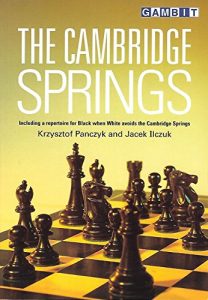"A professional effort where the authors have made their own contributions and have overturned long-held erroneous conclusions. I'm quite happy giving it 9/10" - GM Glenn Flear, New in Chess
The Cambridge Springs is a popular defence to the Queen's Gambit that takes its name from the famous tournament in 1904 during which it was tested in a number of games. Since then it has become firmly established as a club-player's favourite, since Black sets a number of traps and can generate a very quick initiative if White fails to respond precisely. Several world champions have used the Cambridge Springs, most notably Alekhine and Smyslov, while Kasparov has played it on occasion, including a sensationally quick victory over Karpov in 1985. It currently has a good theoretical reputation and is frequently played at grandmaster level.
This is the first major work on the Cambridge Springs. The authors combine thorough research with a wealth of original material to offer comprehensive coverage of this combative system. While the main body of the book covers both sides of the Cambridge Springs, it also offers Black a repertoire against White's alternative options in the Queen's Gambit, the most important of which is the Exchange Variation.
"the coverage here is very thorough and contains reasonable assessments and suggested improvements. ... The Cambridge Springs is rightly popular at club level, being unbalancing, fairly easy to play and also full of some nasty traps for White to fall into" - Richard Palliser, Chess Moves
Krzysztof Panczyk is an international master from Poland, who was placed third in the 1991 Polish Championship. Jacek Ilczuk is a strong correspondence player (a semi-finalist in the e-mail world championship) and has worked as a journalist and editor on a computer magazine.
"This is a truly American opening. Named after the Western Pennsylvanian resort where it was tested three times in 1904, the opening was first played by Emanuel Lasker against Hodges in New York in 1892. Isaac Kashdan played the Cambridge Springs in the 1930s with great success, showing a particular fondness for the two bishops he could obtain in the line 7 Nd2 dxc4. Yasser Seirawan has featured the Cambridge Springs in his repertoire for many years. As the authors point out, one of the great virtues of this opening is both its solidity and counter-attacking potential. ... The Cambridge Springs is that rare opening that can be played by players of a wide range of playing strength, from club enthusiast to grandmaster. Recommended." - IM John Donaldson, USA Team Captain
"Polish authors Panczyk and Ilczuk show how the opening remains a useful weapon in the hands of the black player who wants to avoid well-trodden theoretical lines. It continues to be seen in grandmaster practice, sometimes producing spirited tactical results." - Cecil Rosner, Winnipeg Free Press
"The analysis is both deep and wide, and the two authors have produced a very comprehensive review of the current state of theory in this under-explored variation of the Queen's Gambit." - Alan Sutton, En Passant
The Cambridge Springs is a popular defence to the Queen's Gambit that takes its name from the famous tournament in 1904 during which it was tested in a number of games. Since then it has become firmly established as a club-player's favourite, since Black sets a number of traps and can generate a very quick initiative if White fails to respond precisely. Several world champions have used the Cambridge Springs, most notably Alekhine and Smyslov, while Kasparov has played it on occasion, including a sensationally quick victory over Karpov in 1985. It currently has a good theoretical reputation and is frequently played at grandmaster level.
This is the first major work on the Cambridge Springs. The authors combine thorough research with a wealth of original material to offer comprehensive coverage of this combative system. While the main body of the book covers both sides of the Cambridge Springs, it also offers Black a repertoire against White's alternative options in the Queen's Gambit, the most important of which is the Exchange Variation.
"the coverage here is very thorough and contains reasonable assessments and suggested improvements. ... The Cambridge Springs is rightly popular at club level, being unbalancing, fairly easy to play and also full of some nasty traps for White to fall into" - Richard Palliser, Chess Moves
Krzysztof Panczyk is an international master from Poland, who was placed third in the 1991 Polish Championship. Jacek Ilczuk is a strong correspondence player (a semi-finalist in the e-mail world championship) and has worked as a journalist and editor on a computer magazine.
"This is a truly American opening. Named after the Western Pennsylvanian resort where it was tested three times in 1904, the opening was first played by Emanuel Lasker against Hodges in New York in 1892. Isaac Kashdan played the Cambridge Springs in the 1930s with great success, showing a particular fondness for the two bishops he could obtain in the line 7 Nd2 dxc4. Yasser Seirawan has featured the Cambridge Springs in his repertoire for many years. As the authors point out, one of the great virtues of this opening is both its solidity and counter-attacking potential. ... The Cambridge Springs is that rare opening that can be played by players of a wide range of playing strength, from club enthusiast to grandmaster. Recommended." - IM John Donaldson, USA Team Captain
"Polish authors Panczyk and Ilczuk show how the opening remains a useful weapon in the hands of the black player who wants to avoid well-trodden theoretical lines. It continues to be seen in grandmaster practice, sometimes producing spirited tactical results." - Cecil Rosner, Winnipeg Free Press
"The analysis is both deep and wide, and the two authors have produced a very comprehensive review of the current state of theory in this under-explored variation of the Queen's Gambit." - Alan Sutton, En Passant



